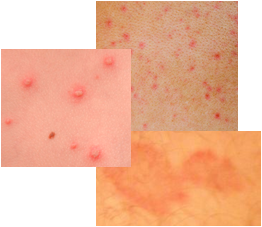Vitamin D Dosage
Visit this
PICTURES OF RASHES PAGE
Daily recommended vitamin D dosages or vitamin D levels vary depending on the age of the individual and whether a woman is pregnant or breastfeeding. Generally, the range of required vitamin D as cholecalciferol on a daily basis is from 200 IU to 800 IU where IU stands for International Units. Ten micrograms of vitamin D is equivalent to 400 International Units.
Different recommendations do exist for the various age groups but the information below should give a general idea about the daily amounts that are required on a daily basis. Speak with your doctor to get more specific information on dosages for vitamin D in the part of the world you reside in.
Less than 12 Months of Age
The vitamin D level for children that are less than 12 months of age ranges from 200 to 400 IUs or 4 to 10 micrograms.
One to 13 Years Old
The vitamin D requirement for children in this age group is from 200 to 600 IUs on average per day. This is equivalent to 5 to 15 micrograms.
Teenagers – 14 to 18 Years of Age
The average daily recommended vitamin D level for teenagers is also 200 to 600 IUs.
Vitamin D Dosage for Adults Up To 70 Years Old
The average daily recommended vitamin D amount ranges from 5 to 15 micrograms.
Pregnant and Breastfeeding Women
The daily requirement for pregnant and breastfeeding women and teens is 600 IUs.
Adults Over 70 Years Old
For elderly individuals in this age group the vitamin D amount is elevated and should be in the 600 to 800 IUs range.
Causes of Vitamin D Deficiency
When discussing vitamin D dosage, it is also important to examine the various causes of vitamin D deficiency, which result in a low vitamin D level in the blood and possible health issues.
Insufficient Sun Exposure
One of the main causes is insufficient sun exposure. Exposure of the skin to sunlight or ultraviolet B sunlight in particular triggers the synthesis or production of vitamin D. Basically, the process involves converting a substance in the skin cells (7-dehydrocholesterol) into the preliminary form of vitamin D3 which is also known as cholecalciferol.
Insufficient exposure to the sun can be due to a variety of reasons such as overuse of sunscreen in the summer months, the long periods of time spent indoors in climates that have long cold winters and days with little sunshine, and dark skin pigmentation due to genetics or suntanned skin. Lifestyle factors play a role as well such as individuals that work indoors most of the time in an office environment for example or those who simply cannot get outdoors in order to get sufficient sun exposure for vitamin D synthesis to occur.
Low Fat Diets or Low Fat Absorption
Vitamin D is a fat-soluble vitamin and therefore, diets that are very low in fat content can lead to low vitamin D levels in the body. In these situations there is simply not enough fat to dissolve the vitamin D that is present. A certain amount of fat is required in diets in order that vitamin D dosage and other fat soluble vitamins and nutrients that are required by the body can be absorbed and used by the body.
Certain health conditions that interfere with the absorption of dietary fat are also causes of vitamin D deficiency. More specifically, these health problems are: Crohn’s disease, cystic fibrosis, pancreatic enzyme deficiency, liver disease, and gall bladder disease. In addition to health conditions that affect fat absorption, other health ailments that affect the parathyroid gland, liver or kidneys can result in a low vitamin D level because the synthesis of active vitamin D is impaired.
Breastfeeding
Breastfeeding is one of the possible causes of vitamin D deficiency. A nursing mother is supplying her infant with a wide range of nutrients and one of those is vitamin D. Infants get very little if any sun exposure and therefore, the majority of the vitamin D dosage needs to come from the breast milk provided by the mother. It is not unusual for both the nursing mother and the infant to have low vitamin D levels.
Therefore, vitamin D supplements are often used to make up for the shortfall in vitamin D. The use of supplements for nursing mothers and infants should always be under the close supervision of a doctor.
Aging Causes of Vitamin D Deficiency
Aging is a problem for maintaining proper vitamin D levels because it causes a reduced production of vitamin D precursors in the skin and a reduction in the ability of the organs to convert vitamin D to its active form.
Other vitamin d resources:
vitamin d benefits | deficiency symptoms | foods | supplements | vitamin d dosage | side effects
